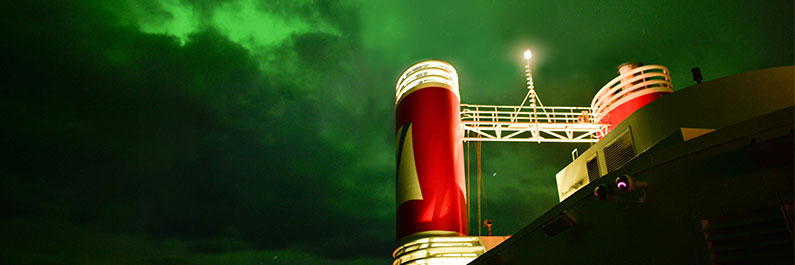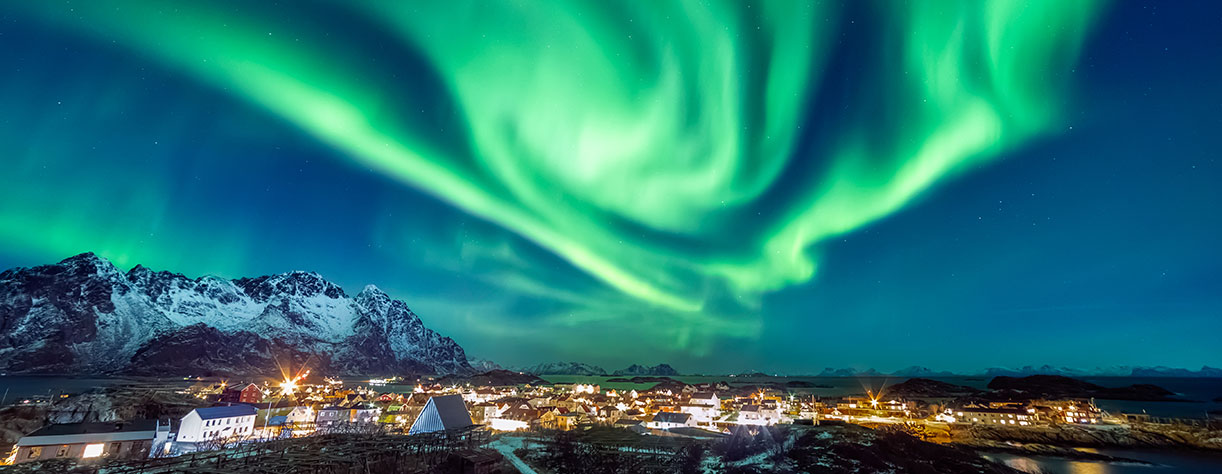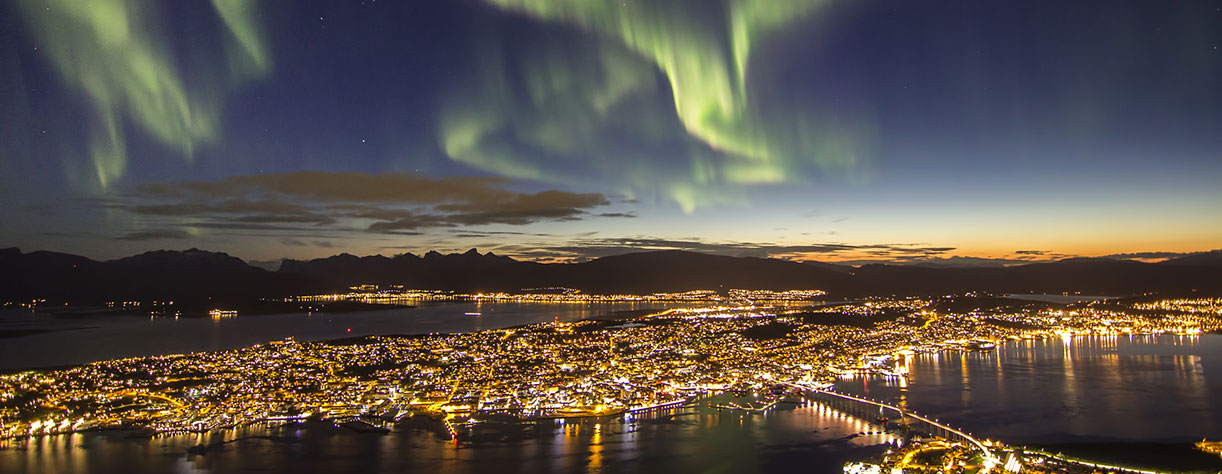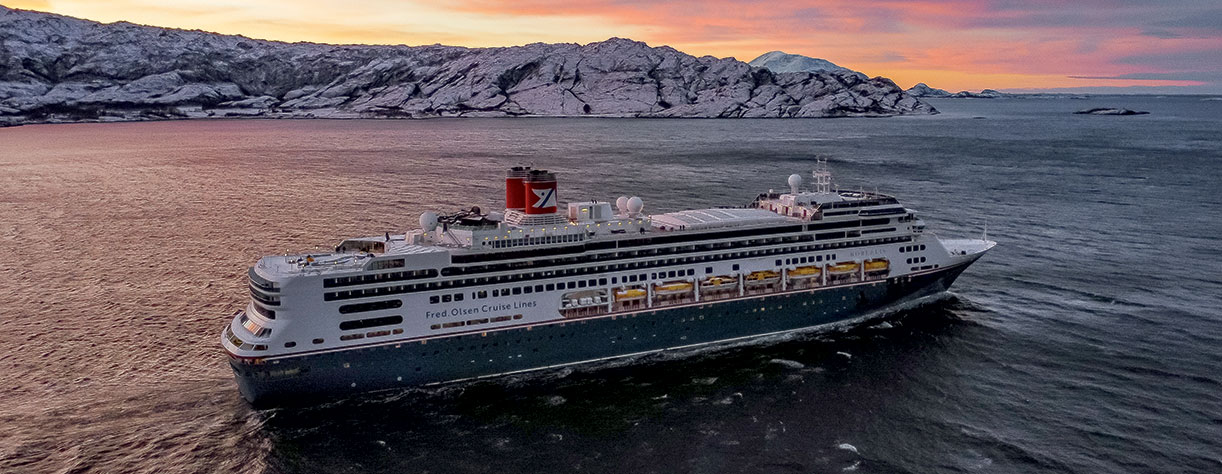Once you've seen the Northern Lights, you never forget it. Some people can even become obsessive Aurora Borealis spotters, cruising miles to sit in cold, dark places to catch a glimpse of the hauntingly beautiful sight. Vikings place mythological meaning on the phenomena, with some believing it was the reflections off Valkyrie shields, and others seeing it as the breath of dead ancestral soldiers. Danes saw it as sleighs, while Estonians saw swans, all with magical backgrounds. Once bitten by its majesty, it's not difficult to see why this seemingly inexplicable phenomenon was given a mythological twist.
But the truth behind the phenomenon is no less fascinating, and is as much a beautiful display as it is a reminder of our place in the universe. In this article we're going to explore the science behind this natural wonder, with a little help from one of our experts, Dr Peter Allan. And to round it off, we're going to let you know how cruising with Fred. Olsen can give you the best chance of witnessing a display of your own (provided you've pleased the sun and weather gods, of course).
We can take you all the way to Tromsø, Ålesund and Alta in the far north of mainland Norway in your quest for wonder. Not only will you cross the Arctic circle, you'll also have an ocean view on the breath-taking mountain vistas, sunrises, sunsets, incredible wildlife and all the magic of this frozen landscape.
Dr Peter Allan
The science of Aurora Borealis
The story of Aurora Borealis is really the echo of the formation and activity of two celestial bodies: the Sun and Earth.
The Sun is a huge ball of super-hot plasma at the centre of the Solar System. So far, it's the only source of life that humans know of, but every living thing on earth, and every planet orbiting it, owes its existence to the Sun's material, gravity and heat. But it's not all rosy – the sun also has violent outbursts, called coronal mass ejections, and a stream of charged particles called the solar wind. Both are dangerous to life, and in the modern world, they can damage satellites or interfere with radio signals.
Now we come down to Earth. Every time a volcano erupts, we're reminded that we're merely passengers on a floating crust, which drifts around on a liquid core of molten rock and metals many miles below. But this liquid core is essential to life. Because of its metallic elements being in content movement, the inner Earth creates a vast magnetic field. On a mundane level, it's what makes our compasses point north, but it also plays an important role in deflecting the Sun's harmful solar wind like a force field.
But how does this make the Aurora Borealis happen?
Over to Dr Peter Allan:
“The Northern Lights are bright regions of the upper atmosphere. They often appear in the form of giant green curtains, although they can take any shape and almost any colour.
Unlike the blue sky in daytime, which is caused by sunlight scattered by the atmosphere, the Northern Lights arise from the atmosphere literally lighting up. This happens when high energy particles from the Sun reach the Earth, where they are funnelled by the Earth’s magnetic field down on to the upper atmosphere near the poles. This puts energy into oxygen atoms which then give out light in a manner rather like a fluorescent light tube.
The closer you are to the Earth’s magnetic poles, the more likely you are to be able to see the Northern Lights. They have been seen in Manchester, although this is very rare. It is not unusual to see them in Scotland, but Scandinavia and Iceland are among the best place to see Northern Lights. To see them, two things need to occur at the same time. Firstly, there needs to have been an outburst from the Sun that is hitting the Earth right at that moment. This will ‘turn the lights on’. Secondly, to actually see them, you need a dark sky that is fairly clear of clouds.
Winter nights that have clear skies are the best time to see Northern Lights. Unfortunately, these cannot be predicted long in advance. To find out when you have the best chance of seeing the lights, you need a weather forecast and an auroral activity forecast. Both are available as apps for smartphones, and I suggest downloading an auroral activity app before coming on the cruise.”
Travel far enough southwards and you can see the southern equivalent, Aurora Australis. It's exactly the same process, but it just happens on the other pole of the "magnet" that is Earth.
Northern Lights holidays
So now you know all about the Northern Lights (and you've downloaded the app), we're pretty sure you want to go and see them. Well, how does a Northern Lights cruise sound?
As you might guess from the name, Fred. Olsen has its roots in Norway– Oslo, to be precise – so we're your perfect guides to nature's most awesome display from your ocean view cabin. We base whole itineraries around giving our guests the chance to see the lights, so if you like cruising and natural wonders, come and join us.
We pride ourselves on offering an experience that is as informative and magical as a cruise around Norway should be. The chance to view the famous lights in the Norwegian sky is something that needs to be seen to be believed and our decks are the perfect place for that. We offer the comfort of home with the breathtaking view of Norway and there is no better way to take advantage of that than one of Our Sky at Sea experience’s. Stargaze or try spot the famous lights and if you start to get cold our crew will always be on hand to offer you a blanket so you can carry on taking in the spectacular surroundings.
If you look through our section on cruises to Norway, you'll notice several itineraries named after the phenomenon, and others named after the Arctic locations you'll visit or see. On board Borealis, Balmoral or Bolette, you'll get the chance to cross the Arctic Circle, sail deep into fjords, look for and spot amazing ocean wildlife, and visit places you might have heard of like Tromsø, Alta, Ålesund, Torghatten and Bodø. And yes, if the solar and meteorological conditions are in alignment, you'll also have the chance to put the icing on the cake with a vision of that magical swirling glow in the sky. November through to February offer the darkest skies and longer evenings for maximum sky-gazing. The strongest lights tend to appear between 9pm and 2am, though the best sightings occur between 11pm and midnight.
"In Search of the Northern Lights" is cruising in style with a very distinct goal. We run similar itineraries several times a year around the winter months, and we leave from Liverpool, Dover, Newcastle and Southampton, so search through them and find the one that best fits your cruising schedule.
The specific itineraries vary from cruise to cruise depending on the time of year and the duration of the trip, but you can expect to sail far into the Northernmost parts of Norway, to places like Honningsvag, Tromsø, Sortland, Hammerfest and Alta. These are true picture postcard towns, with snow-capped (or likely covered) mountains, welcoming communities and amazing food on offer. Visiting these remote places is spiritually uplifting too – these are people who put up with conditions that would bring the UK to a halt if they happened for a day, but they have adapted and thrived there.
No Northern Lights cruise would be complete without gazing on the iconic Seven Sisters mountain range halfway up the country on the island of Alsta. They are not to be confused with the Seven Sister waterfall, however. The falls are slightly more inland, 200km north of Bergen, and can't be seen from the sea. You can visit them on a Norwegian Fjord cruise with Fred. Olsen which tend to be summertime cruises meaning you will get to experience the incredible midnight sun.
Travel the Olsen way
When you choose Fred. Olsen to take you up north, you get much more than an ocean view and all the pleasures of Borealis, Balmoral or Bolette. You'll also benefit from our local knowledge, our comfortable, spacious cabins, and a helping hand from the incredible crew all the way from the UK to Northern Norway. Find out more about the Olsen way here.






